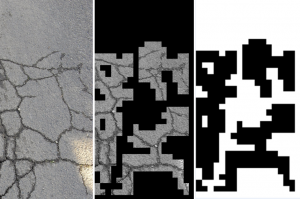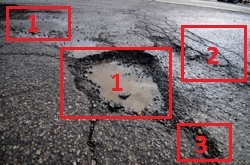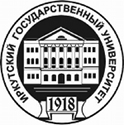The road surface was affected as the natural elements, vehicles in traffic. After some time on the road surface occur defects. Engineers are commonly used to collect pavement surface distress data, during periodic road surveys, but it takes a lot of time and manpower. In our research, we present our automatic defects detection and classification on road pavement method. We want to introduce the method determine the different types of disability as rupture of the road edge, potholes, subsidence depressions. Images of road pavement is preprocessing to noise filter and smooth, then to classify two class — defects/ not defects, next step to process with defects class. We have three main steps to process: First step is to detect defect position (ROI). In second step, defect is extracted into features. The last step is to classify defect using different defect features extracted from the second step. In our approach considers Gabor transform (GT) [1] using machine learning algorithms: Markov Random Fields [2] and Random Forests [3], Support vector machine algorithm [4].
Fig. 1: Result of segmentation based on Random Forest algorithm
Data collection on real roads, real-time processing and comparison with other algorithms, analyzes the advantages and disadvantages of each methods. At this moment we have collected already 500 images of road defects for research.
Fig. 2: Result of segmentation based on Random Forest algorithm
This figure 2 shows the expected result, where: 1 — Pothole, 2 — cracks network, 3 — deep fractures.
Nguyen Thu Huong
[Bibtex]
@article{lee1996image,
title={Image representation using 2D Gabor wavelets},
author={Lee, Tai Sing},
journal={Pattern Analysis and Machine Intelligence, IEEE Transactions on},
volume={18},
number={10},
pages={959--971},
year={1996},
publisher={IEEE}
}[Bibtex]
@inproceedings{bouman1995markov,
title={Markov random fields and stochastic image models},
author={Bouman, Charles A and Sauer, Ken and Saquib, Suhail},
booktitle={1995 IEEE International Conference on Image Processing},
year={1995}
}@article{breiman2001random,
title={Random forests},
author={Breiman, Leo},
journal={Machine learning},
volume={45},
number={1},
pages={5--32},
year={2001},
publisher={Springer}
}[Bibtex]
@article{cortes1995support,
title={Support-vector networks},
author={Cortes, Corinna and Vapnik, Vladimir},
journal={Machine learning},
volume={20},
number={3},
pages={273--297},
year={1995},
publisher={Springer}
}




